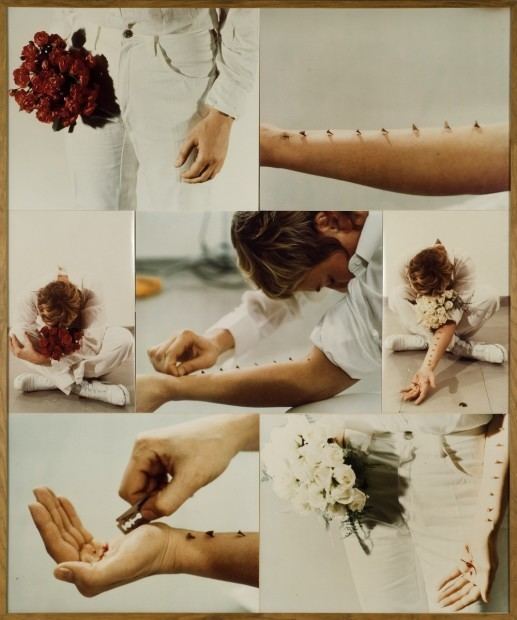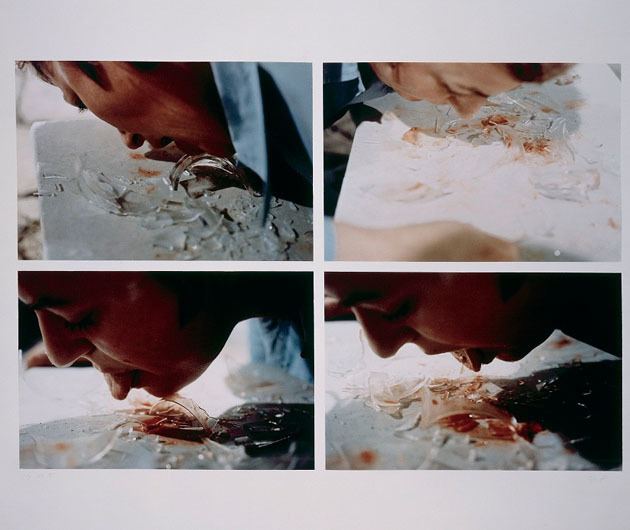Nationality French | Name Gina Pane | |
 | ||
Books Situation Ideale, Gina Pane | ||
Otto la minute d art contemporain gina pane
Gina Pane (Biarritz, May 24, 1939 – Paris, March 6, 1990) was a French artist of Italian origins. She studied at the École des Beaux-Arts in Paris from 1960 to 1965 and was a member of the 1970s Body Art movement in France, called "Art corporel".
Contents
- Otto la minute d art contemporain gina pane
- Gina pane exhibition backstage
- Biography
- Work
- Links
- References

Parallel to her art, Pane taught at the Ecole des Beaux-Arts in Mans from 1975 to 1990 and ran an atelier dedicated to performance art at the Centre Pompidou from 1978 to 1979 at the request of Pontus Hulten.

Pane is possibly best known for her performance piece The Conditioning (1973), in which she is laid on a metal bedframe over an area of burning candles. The Conditioning was recreated by Marina Abramović as part of her Seven Easy Pieces (2005) at the Solomon R. Guggenheim Museum in New York in 2005.

Gina Pane's estate is managed by her former partner Anne Marchand. She is represented by Galerie Kamel Mennour in Paris.

Gina pane exhibition backstage
Biography

Born in Biarritz to Italian parents, Pane passed part of her life in Italy. She returned to France to study under André Chastel at the Ecole des Beaux-Arts in Paris from 1960-1965. She died prematurely in 1990 following a long illness.
Extreme self-inflicted injury featured in much of Pane's performance work, distinguishing her from most other female body artists of the 1970s. Through the violence of cutting her skin with razor blades or putting out fires with her bare hands and feet, Pane intended to incite a "real experience" in the viewer, who would be moved to empathize with her discomfort. The shocking nature of these early performances — or "actions," as she preferred to call them — often overshadowed her prolific photographic and sculptural practice. However, the body was a central concern in all of Pane's work, whether literally or conceptually.
Pane claimed that she was greatly influenced by political protests in Paris in May 1968, and by such international conflicts as the Vietnam War (Ferrer 1989, pp. 37–8). In Nourriture-actualités télévisées-feu (1971; repr. Pluchart 1971) she force-fed herself and spat back up 600 grammes of raw ground meat, watched the nightly news on television as she stared past a nearly blinding light bulb, and extinguished flames with her bare hands and feet. After the performance, she said, people reported a heightened sensitivity. "Everyone there remarked: 'It's strange, we never felt or heard the news before. There's actually a war going on in Vietnam, unemployment everywhere.'" (Stephano 1973, p. 22)
Work
From 1962-1967 Pane produced geometric abstraction and created a number of metal sculptures by bending sheets of metal into simple shapes, the structures and her use of primary colors being reminiscent of minimal art. From her academic training, however, Pane developed an interest in the human body and turned to making sculpture and installation. This work considered the relationship between the body and nature. In 1968, Pane began making minutely prepared and documented actions in which each gesture was imbued with a ritual dimension.
Pane distinguishes three periods of her artistic evolution:
• 1968-1971: Placing the body in nature. Works include Displaced Stones (1968), Protected Earth (1968-1970), and Enfoncement d'un rayon de soleil (1969). In Unanaestheticized Climb (1971) she climbed, barefoot, a ladder with rungs studded with sharp metal protrusions, stopping when she could not longer endure the pain.
• 1970-late 1970s: The active body in public. Pane considered space and time to be the material for these works. All that remains of these works are photographic documentation of carefully chosen moments and the performative object. These actions constitute a research into another language. They seek to transform the individual through willed communication with the Other. This work rejects aestheticism in order to produce a new image of beauty. In 1973 at the Galerie Diagramma in Milan, Pane executed Sentimental Action before an audience, the first row of which was exclusively female. Pane twice repeated an action twice, the first time with a bouquet of red roses, and the second time with a bouquet of white roses. Passing progressively from standing to the fetal position, she executed first a back-and-forth movement with the bouquet, before pressing the thorns of a rose into her arms and making an incision with a razor blade on the palm of her hand. The form of the wounds on her arm resembled the petals and stem of a rose. She described this work as a ‘projection of an intra space’ that dealt with the mother–child relationship.
• Late 1970s-onward: Relationship of the body to the world. For the installation series Action Notation she mixed photographs of her previous wounds with objects, such as toys, glass, etc., from her previous actions. The process was controversial since it almost always involved an element of masochism: climbing up a ladder studded with razor blades, cutting her tongue or her ear, sticking nails into her forearm, smashing through a glass door, ingesting food to the point of nausea. Pane no longer based her approach on direct bodily experience, although the body remained pivotal and retained its symbolic significance through figures (cross, rectangle, circle) and materials (burnt or rusty metal, glass or copper).
Links
"Gina Pane," kamel mennour accessed Feb. 1 2014
